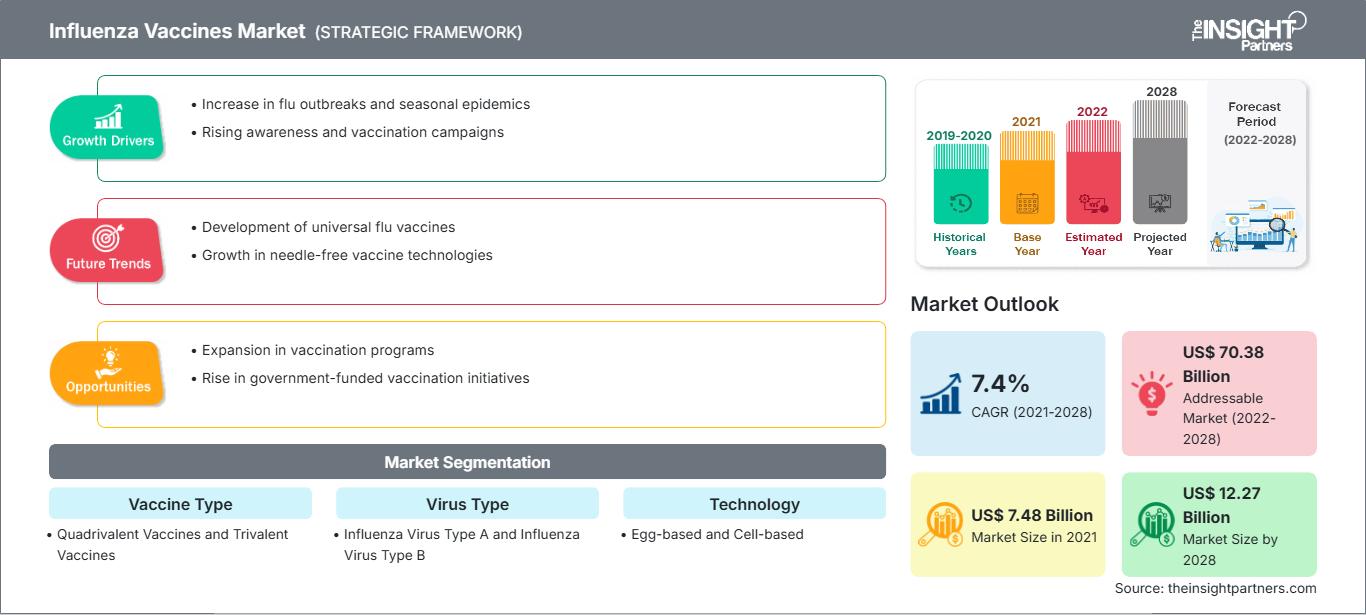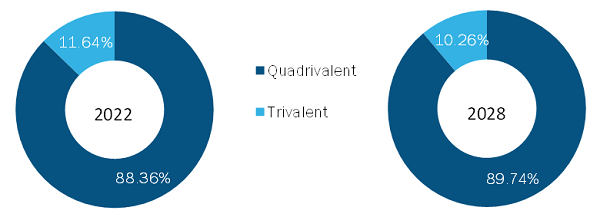The influenza vaccines market was valued at US$ 7,478.53 million in 2021 and it is expected to grow US$ 12,272.49 million by 2028; with a CAGR of 7.4% from 2022 to 2028
Influenza is a contagious respiratory infection caused due to influenza virus. Influenza is noticed by fever, cough, muscle and joint pain, headache, and severe weakness. Illness due to influenza varies from mild to severe, sometimes leading to death. According to the World Health Organization (WHO), 2018, influenza cases related hospitalization ranges from 3-5 million cases for severe illness, whereas deaths related to influenza are about 290,000 to 650,000. Vaccines are adviced for the prevention of influenza infections. The rapid spread of influenza virus epidemics worldwide propels demands for developing an efficient influenza vaccine. A strong product pipeline is a key factor driving the market's growth during the forecast period.
The influenza vaccines market is analyzed on the basis of vaccine type, virus type, technology, route of administration, target group, and geography. By geography, the market is broadly segmented into North America, Europe, Asia Pacific, the Middle East & Africa, and South & Central America. The influenza vaccines market report offers insights and in-depth analysis of the market, emphasizing market trends, technological advancements, market dynamics, and the competitive analysis of the leading market players.
Customize This Report To Suit Your Requirement
You will get customization on any report - free of charge - including parts of this report, or country-level analysis, Excel Data pack, as well as avail great offers and discounts for start-ups & universities
Influenza Vaccines Market: Strategic Insights

-
Get Top Key Market Trends of this report.This FREE sample will include data analysis, ranging from market trends to estimates and forecasts.
Lucrative Regions for Influenza Vaccines Market
- This FREE sample will include data analysis, ranging from market trends to estimates and forecasts.
Market Insights
Increasing Investment by Top Market Players and Governments to Drive Influenza Vaccines Market
Market players and governments worldwide are increasing their investments in vaccine development and immunization. For instance, In March 2021, Sanofi announced an approximately US$ 925 million investments in a new vaccine manufacturing plant at its pre-existing site in Toronto and Canada. Investments in the new facility will provide additional antigen and filling capacity for Sanofi's FLUZONE high-dose quadrivalent influenza vaccines, increasing availability in Canada, the US, and Europe in the years to come.
- In April 2021, 3 levels of government - federal, provincial and municipal - supported Sanofi Pasteur in building an "end-to-end" influenza vaccines factory in Toronto. The partners will invest nearly US$ 1 billion to get the site up and running, slated for 2027. Paris-based Sanofi, for its part, will invest more than US$ 55 million, create 165 new eligible jobs, and maintain another 1,100. The federal government is investing US$ 55 million, while the Ontario government is contributing US$ 55 million, making it a US$ 925 million project. In addition, Sanofi will also invest at least US$ 79 million annually over 8 years to fund research and development in Canada.
- In November 2020, Vaccine maker Seqirus planned to invest US$ 800 million in a significant Australian vaccine manufacturing center. The new plant will be located at Tullamarine in the business district of Melbourne Airport and is expected to come online in 2026, Seqirus said. The company did not disclose the desired square meter area in a statement.
- In March 2022, The Australian Government announced a US$ 100 million investments in a seasonal flu vaccine. The objective of this investment is to protect people from influenza and COVID-19 to minimize its impact on healthcare in Australia.
- In June 2021, The European Investment Bank signed a US$ 30.55 million global vaccine distribution agreement with biotech company Univercells to mass produce the COVID-19 vaccine at a new Belgian site. It helped build other vaccine factories around the world. In April 2022, the Bank provided a US$ 15.27 million loan to Italian biomedical research company IRBM to expand its vaccine production capacity and strengthen research on coronaviruses and other diseases.
Thus, the increase in investment by top market players and governments across the globe is bolstering the influenza vaccines market.
Vaccine Type Insights
Based on vaccine type, the global influenza vaccines market is segmented into quadrivalent vaccines and trivalent vaccines. The quadrivalent segment held a larger share of the market in 2021. The same segment is expected to grow faster over the forecast period. The increasing product approvals and rising product launches for market expansion are among the primary drivers of the quadrivalent vaccine segment growth.
Influenza Vaccines Market, by Vaccine Type – during 2022–2028


- This FREE sample will include data analysis, ranging from market trends to estimates and forecasts.
Based on virus type, the global influenza vaccines market is segmented into influenza virus type A and influenza virus type B. The influenza virus type A segment held a larger market share in 2021. The same is expected to grow faster over the forecast period due to the increasing prevalence of influenza type A. The market growth of the influenza virus type A segment is attributed to it being the most common form of influenza. It can infect animals, although illnesses associated with this type of flu are more common.
Product Approvals and Collaborations are highly adopted strategies by influenza vaccines market players. A few of the recent key market developments are listed below:
- In July 2022, The US Food and Drug Administration (FDA) approved Sanofi's licensure request for vaccine approval for the upcoming 2022-2023 flu season, including Fluzone High-Dose Quadrivalent (Influenza Vaccine), Flublok Quadrivalent (Influenza Vaccine), and Fluzone Quadrivalent (Influenza Vaccine). This approval comes on the heels of the CDC's Advisory Committee on Immunization Practices (ACIP) preferential recommendation for adults 65+ including Fluzone High-Dose Quadrivalent and Flublok Quadrivalent.
- In July 2022, GSK announced an agreement with the Government of Canada for pandemic and seasonal influenza vaccines to help protect Canadian adults and children. The four-year agreement, spanning through March 2026, includes the supply of as many as 80 million doses of Arepanrix (adjuvanted pandemic influenza vaccine) in the event of an influenza pandemic(s) and a minimum of 4 million doses per year of Flulaval Tetra (seasonal influenza vaccine).
The COVID-19 pandemic is expected to boost the global influenza vaccines market growth, owing to the increasing demand for influenza vaccines during a pandemic. According to data published by the Centers for Disease Control and Prevention in November 2021, the overall influenza vaccine administration in the US increased by 9.0% from September to December 2020, with more doses administered to adolescents and adults than in September to December 2018 and 2019.
Influenza Vaccines– Market Segmentation
The global influenza vaccines market is analyzed on the basis of vaccine type, virus type, technology, route of administration, target group, and geography. Based on vaccine type, the market is segmented into quadrivalent vaccines and trivalent vaccines. Based on virus type, the market is segmented into influenza virus type A and influenza virus type B. Based on technology, the market is bifurcated into egg-based and cell-based. Based on route of administration, the market is segmented into injection and nasal spray. Based on target group, the market can be segmented into infants, children, adults, and elderly. By geography, the influenza vaccines market is segmented into North America, Europe, Asia Pacific, the Middle East & Africa, and South & Central America.
Company Profiles
Moderna, Inc.; SEQIRUS; Sanofi; GlaxoSmithKline plc; Hualan Biological Engineering Inc.; Emergent BioSolutions Inc.; Mitsubishi Chemical Group Corporation; Serum Institute of India Pvt. Ltd; Mylan N. V.; and AstraZeneca are the key companies operating in the influenza vaccines market. The companies are taking up product innovation strategies to meet the evolving customer demands globally, allowing them to maintain their brand name in the global influenza vaccines market
Influenza Vaccines Report Scope
| Report Attribute | Details |
|---|---|
| Market size in 2021 | US$ 7.48 Billion |
| Market Size by 2028 | US$ 12.27 Billion |
| Global CAGR (2021 - 2028) | 7.4% |
| Historical Data | 2019-2020 |
| Forecast period | 2022-2028 |
| Segments Covered |
By Vaccine Type
|
| Regions and Countries Covered |
North America
|
| Market leaders and key company profiles |
|
Frequently Asked Questions
Which segment by vaccine type led the influenza vaccines market?
Which region is projected to be the fastest-growing region in the global influenza vaccines market?
What is the estimated influenza vaccines market size in 2021?
What are the growth estimates for the influenza vaccines market till 2028?
What is the market CAGR value of the influenza vaccines market during the forecast period?
Who are the major players in the influenza vaccines market across the globe?
What are the driving factors for the global influenza vaccines market across the world?
What are influenza vaccines?
- Historical Analysis (2 Years), Base Year, Forecast (7 Years) with CAGR
- PEST and SWOT Analysis
- Market Size Value / Volume - Global, Regional, Country
- Industry and Competitive Landscape
- Excel Dataset
Recent Reports
Testimonials
Reason to Buy
- Informed Decision-Making
- Understanding Market Dynamics
- Competitive Analysis
- Identifying Emerging Markets
- Customer Insights
- Market Forecasts
- Risk Mitigation
- Boosting Operational Efficiency
- Strategic Planning
- Investment Justification
- Tracking Industry Innovations
- Aligning with Regulatory Trends





















 Get Free Sample For
Get Free Sample For